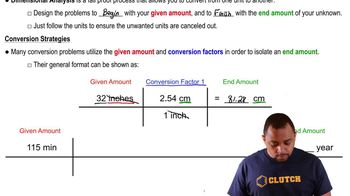Textbook Question
(b) The Sears Tower in Chicago is 1454 ft tall. Calculate its height in meters.
1
views
 Verified step by step guidance
Verified step by step guidance



(b) The Sears Tower in Chicago is 1454 ft tall. Calculate its height in meters.
(c) The Vehicle Assembly Building at the Kennedy Space Center in Florida has a volume of 3,666,500 m3. Convert this volume to liters and express the result in standard exponential notation.
(d) An individual suffering from a high cholesterol level in her blood has 242 mg of cholesterol per 100 mL of blood. If the total blood volume of the individual is 5.2 L, how many grams of total blood cholesterol does the individual's body contain?
Perform the following conversions: (b) 0.0550 mi to m
Perform the following conversions: (c) $1.89/gal to dollars per liter
Perform the following conversions: (d) 0.510 in./ms to km/hr